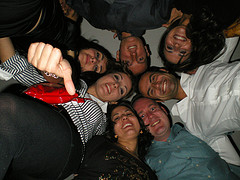 A motivational speech varies in length. Usually an inspirational speaker will deliver a 45 to 90 minute motivational speech. This is a limited time frame and usually involves a larger crowd, so interaction may be limited.
A motivational speech varies in length. Usually an inspirational speaker will deliver a 45 to 90 minute motivational speech. This is a limited time frame and usually involves a larger crowd, so interaction may be limited.
To get the most out of your motivational speaker budget, invite your keynote speaker to also deliver a workshop or break out session.
In these longer sessions, more content can be digested and the inspirational message can be reinforced. Interaction is a must to keep the audience awake and engaged. In a longer session, I like to present some motivational speech activities that tie together my content and engage the audience.
Here is one of those motivational speech activities:
The Buck Stops Here
1)Ask participants to take out a dollar bill (in Canada, we use loonies, because we like loose change) or any other denomination they have ($2, $5, a quarter)
Have participants wave the money in the air and find someone near them that has the same denomination.
Tell them they now have the opportunity to share valuable information (relative to the course or a certain topic) and get paid for it. The catch is the other person has to decide if the information is really that valuable. If it is, they will pay for it. If it's not, they won't.
Participants now search for things that would be valuable and helpful to tell there partners and, to increase its value, interesting ways to give them the information. There are no rules about what can be shared - gossip, bribery, joke telling ... are all legally possible.
You can frame the discussion around your topic, a corporate event or change going on in the organization to make it more relevant. The partner must decide if the information has value (if it's interesting, relevant or new information) or if it holds no interest for them (they already know this or don't care).
After a short time period, instruct the group to decide if the information was of value and pay up, then the other partner gets a crack at it. Depending upon their "financial situation" they are to either sit down (if they are broke) or carry on a conversation with someone else.
At the end, tally up the money and decide who wins!
To debrief the motivational speech activity, ask people to reflect on:
What made information valuable? Value is usually determined by:
- Relevance to the person ( i.e. if your partner is an accountant, you might tell them about a new accounting software you've heard of)
- The information itself and its impact on your partner and/or a larger group
- The timeliness of the information shared
- The presentation of the information
The presentation is often overlooked. Think about how you present information to others at work and how you could make it more valuable and relevant.
I was a motivational keynote speaker for a manufacturing company recently. While there, I attended a longer training session put on by another guest speaker, Rhoda Jennings. With her permission, here are some activities she used to personalize the staff appreciation event, to increase communication, and to engage the group:
- Think of an inspirational quote, company motto or mission statement.
- On index cards, put one word from the quote on each card
- Break up the audience into groups (preferably the same number of people per group as the number cards for each quote)
- Hand out a card to each person in the group
- Instruct the groups to move around to get the cards in the order that translates the motivational quote.
- Give a time limit - and the first team to unscramble the quote wins!
- Debrief the activity by having each team explain what the motivational quote means to their team. Also ask who provided leadership in this activity and how?
Blind Driver:
- Have audience members partner up, one person is a driver and the other is the back seat driver
- The driver stands in front with eyes closed and their arms out in front on an imaginary steering wheel in the 10 o'clock and 2 o'clock position.
- The person behind (the back seat driver) instructs them to steer clear of obstacle with only verbal signals (stop, turn right, veer left, etc)
- After a couple of minutes of driving, ask the drivers to open their eyes
- The driver should tell the back seat driver what worked about their instruction and what could have been better.

